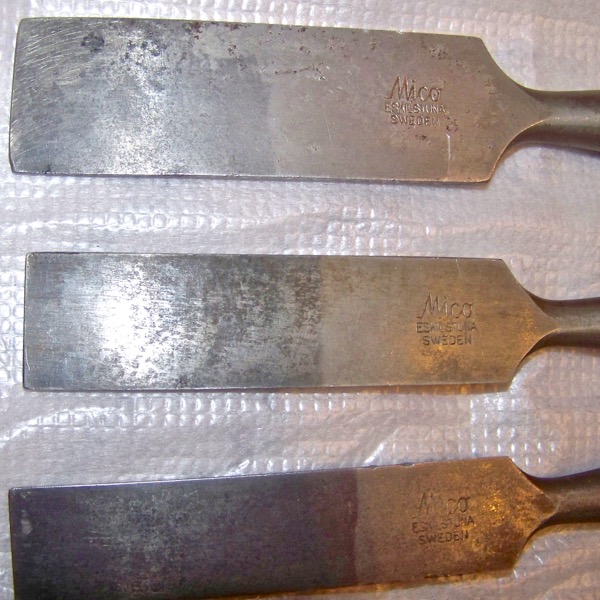Mico Chisels – Additional Info
Contributed by Randall Nelson
I have a set of six chisels stamped “Mico” that I purchased on Ebay from a man in Florida who said he had purchased them at a yard sale in Quebec. They are 1 ¼”, 1”, 7/8”, ½”, 3/8” and ¼”, all are socket style chisels and the blades are longer than the usual butt chisel length. The blades are each 3¾” long, not including the socket. There is very little variation in length and only one of the handles shows much wear from actual use.

The stamp, on the edge side is “Mico” (in italics) | “ESKILSTUNA” |”SWEDEN”; the two smallest sizes are only stamped “SWEDEN”.

There are no markings on the front of the blade. The sockets are all flared and rounded (F&R) at the top, unlike the flared and squared (F&S) design that is typically seen on all socket chisels made by Berg and Jernbolaget.


Heat treating lines are obvious on the larger blades, going up 2” to 2 ½” per blade from the edge, so only about 50% of the blade is hardened.

The handle stickers are a square with rounded edges, done as gold fleck field with red edging and lettering and 3 closely-spaced concentric rings inside the square. Inside the rings it says “Mico” in italics, in the same lettering pattern as the blade stamp. Below the circle, but still within the square it says Sweden.

The handles are all very attractive birch, finished with orange shellac, and 3 of the 6 are masur birch. The largest handle for the 1 ¼” chisel. shows differences in proportion and finish from the other 5. The finish is thinner, not as orange or as heavily applied. The proportions and spacing of the decorative rings are slightly different, as is the hammer ring, which is blued steel and is held in place by 2 flat head brads through holes in the ring.

The other five chisels have no holes in their rings, which are held in place by the same type of flat head brads nailed above the rings. The handles were all turned to accept the heavier Berg or Jernbolaget style rings, but none of the rings on these Mico chisels fit properly, since they had been made to go on Solliden-style chisel handles. as pictured below.

Solliden-style rings are typically thin and slightly rounded over at the top, to cover the “step” at the upper end of the handle. This was done so that the ring would look thicker and more substantial than it really was, but it causes the ring to be smaller and tighter at the top than at the bottom.

As a result, if the end of the handle is turned to fit the upper, tighter dimension of the ring, there will be noticeable “slop” where the bottom section of the ring is too big for the handle. This, combined with the inaccurate nailing of the flat head brads would have made these chisels difficult and uncomfortable to use. Only 1 of the 6 chisels has a tightly fitted ring. I think this is a clear example of a small-time manufacturer, trying to make do with what could be obtained quickly to fill out an order.

All of these socket chisels exhibit parallel stamping marks on the socket shafts, from the use of a drop hammer in the forging process. These forging marks have only been partially ground out in the finishing process, unlike Berg or Jernbolaget socket chisels, which are always completely smooth and never show any such forging marks. They also all exhibit some degree of irregularity in the grinding of the bevels and especially in the intersection of the blade and the beginning of the socket, showing evidence of free-hand grinding; some are slightly off-set to the left, some to the right. This would indicate small production runs, vs the precise machining typically observed on Berg and Jernbolaget production.

Contributed by Randall Nelson
Leave a Reply